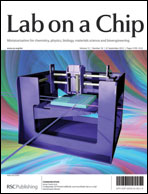We describe a new device concept for digital microfluidics, based on an active matrix electrowetting on dielectric (AM-EWOD) device. A conventional EWOD device is limited by the number of electrical connections that can be made practically, which restricts the number and type of droplet operations. In an AM-EWOD, the patterned electrodes of a conventional EWOD device are replaced by a thin film transistor (TFT) array, as found in a liquid crystal display (LCD), facilitating independent control of each electrode. The arrays can have many thousand individually addressable electrodes, are fully reconfigurable and can be programmed to support multiple simultaneous operations. Each element is 210 μm × 210 μm in size and contains a circuit that measures the electrical impedance of the liquid above it. This is used to determine the presence and size of a droplet, a method that can improve assay reliability and accuracy. This sensor provides feedback, error detection and closed loop control of an assay sequence. We describe the design, fabrication and testing of a 64 × 64 format AM-EWOD device with impedance sensor functionality. A colorimetric assay is implemented on the device and used to measure glucose in human blood serum. Results are compared with the same assay performed on a microtitre plate.

You have access to this article
 Please wait while we load your content...
Something went wrong. Try again?
Please wait while we load your content...
Something went wrong. Try again?


 Please wait while we load your content...
Please wait while we load your content...